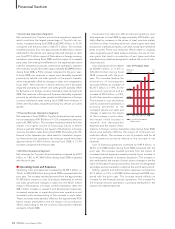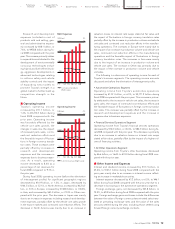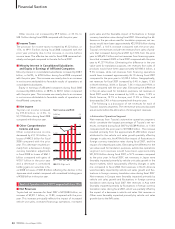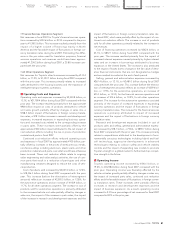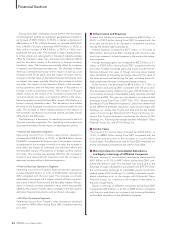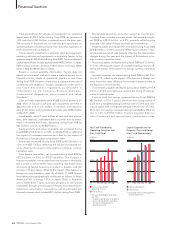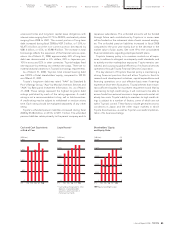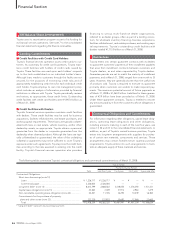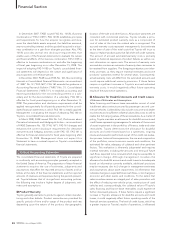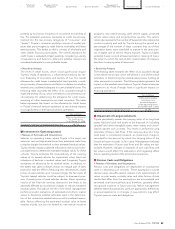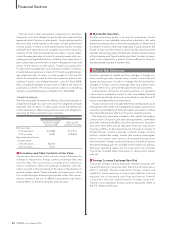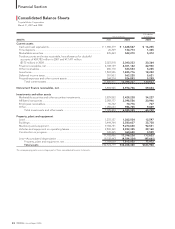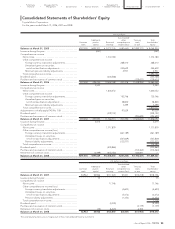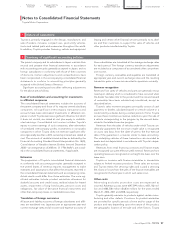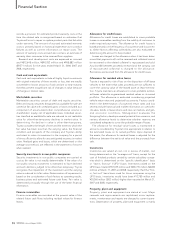Toyota 2008 Annual Report Download - page 90
Download and view the complete annual report
Please find page 90 of the 2008 Toyota annual report below. You can navigate through the pages in the report by either clicking on the pages listed below, or by using the keyword search tool below to find specific information within the annual report.
88 TOYOTA •Annual Report 2008 •
Financial Section
■
■
■
In December 2007, FASB issued FAS No. 141(R),
Business
Combinations
(“FAS 141(R)”). FAS 141(R) establishes principles
and requirements for how the acquirer recognizes and mea-
sures the identifiable assets acquired, the liabilities assumed,
any noncontrolling interest, and the goodwill acquired in a busi-
ness combination or a gain from a bargain purchase. Also, FAS
141(R) provides several new disclosure requirements that
enable users of the financial statements to evaluate the nature
and financial effects of the business combination. FAS 141(R) is
effective to business combinations on and after the beginning
of fiscal year beginning on or after December 15, 2008. The
impact of adopting FAS 141(R) on Toyota’s consolidated finan-
cial statements will depend on the nature and significance of
any acquisitions in the future period.
In December 2007, FASB issued FAS No. 160,
Noncontrolling
Interests in Consolidated Financial Statements—an amendment
of “ARB” No. 51
(“FAS 160”). FAS 160 amends the guidance in
Accounting Research Bulletin (“ARB”) No. 51,
Consolidated
Financial Statements
(“ARB 51”), to establish accounting and
reporting standards for the noncontrolling interest in a sub-
sidiary and for the deconsolidation of a subsidiary. FAS 160 is
effective for fiscal years beginning on or after December 15,
2008. The presentation and disclosure requirements shall be
applied retrospectively for all periods presented in the consoli-
dated financial statements in which FAS 160 is initially applied.
Management is evaluating the impact of adopting FAS 160 on
Toyota’s consolidated financial statements.
In March 2008, FASB issued FAS No. 161,
Disclosures about
Derivative Instruments and Hedging Activities— an amendment
of FASB Statement No. 133
(“FAS 161”). FAS 161 changes and
enhances the current disclosure requirements for derivative
instruments and hedging activities under FAS 133. FAS 161 is
effective for financial statements for fiscal years beginning after
November 15, 2008. Management does not expect this
Statement to have a material impact on Toyota’s consolidated
financial statements.
The consolidated financial statements of Toyota are prepared
in conformity with accounting principles generally accepted in
the United States of America. The preparation of these financial
statements requires the use of estimates, judgments and
assumptions that affect the reported amounts of assets and lia-
bilities at the date of the financial statements and the reported
amounts of revenues and expenses during the periods present-
ed. Toyota believes that of its significant accounting policies,
the following may involve a higher degree of judgments, esti-
mates and assumptions:
■Product Warranty
Toyota generally warrants its products against certain manufac-
turing and other defects. Product warranties are provided for
specific periods of time and/or usage of the product and vary
depending upon the nature of the product, the geographic
location of the sale and other factors. All product warranties are
consistent with commercial practices. Toyota includes a provi-
sion for estimated product warranty costs as a component of
cost of sales at the time the related sale is recognized. The
accrued warranty costs represent management’s best estimate
at the time of sale of the total costs that Toyota will incur to
repair or replace product parts that fail while still under warranty.
The amount of accrued estimated warranty costs is primarily
based on historical experience of product failures as well as cur-
rent information on repair costs. The amount of warranty costs
accrued also contains an estimate of warranty claim recoveries to
be received from suppliers. The foregoing evaluations are inher-
ently uncertain, as they require material estimates and some
products’ warranties extend for several years. Consequently,
actual warranty costs will differ from the estimated amounts and
could require additional warranty provisions. If these factors
require a significant increase in Toyota’s accrued estimated
warranty costs, it would negatively affect future operating
results of the automotive operations.
■Allowance for Doubtful Accounts and Credit Losses
• Natures of Estimates and Assumptions
Sales financing and finance lease receivables consist of retail
installment sales contracts secured by passenger cars and com-
mercial vehicles. Collectibility risks include consumer and dealer
insolvencies and insufficient collateral values (less costs to sell) to
realize the full carrying values of these receivables. As a matter of
policy, Toyota maintains an allowance for doubtful accounts and
credit losses representing management’s estimate of the amount
of asset impairment in the portfolios of finance, trade and other
receivables. Toyota determines the allowance for doubtful
accounts and credit losses based on a systematic, ongoing
review and evaluation performed as part of the credit-risk evalua-
tion process, historical loss experience, the size and composition
of the portfolios, current economic events and conditions, the
estimated fair value, adequacy of collateral and other pertinent
factors. This evaluation is inherently judgmental and requires
material estimates, including the amounts and timing of future
cash flows expected to be received, which may be susceptible to
significant change. Although management considers the
allowance for doubtful accounts and credit losses to be adequate
based on information currently available, additional provisions
may be necessary due to (i) changes in management estimates
and assumptions about asset impairments, (ii) information that
indicates changes in expected future cash flows, or (iii) changes in
economic and other events and conditions. To the extent that
sales incentives remain an integral part of sales promotion with
the effect of reducing new vehicle prices, resale prices of used
vehicles and, correspondingly, the collateral value of Toyota’s
sales financing and finance lease receivables could experience
further downward pressure. If these factors require a significant
increase in Toyota’s allowance for doubtful accounts and credit
losses, it could negatively affect future operating results of the
financial services operations. The level of credit losses, which has
a greater impact on Toyota’s results of operations, is influenced
Critical Accounting Estimates


